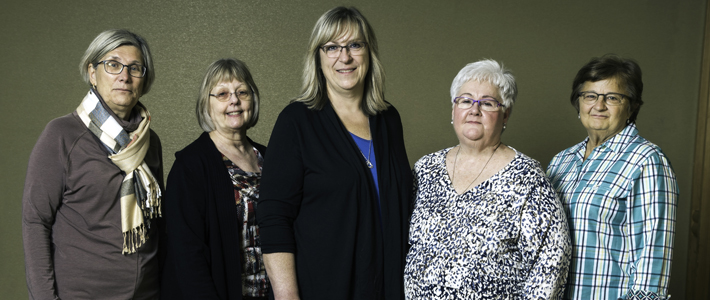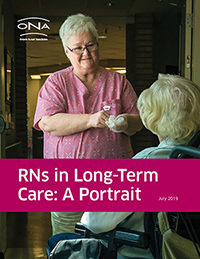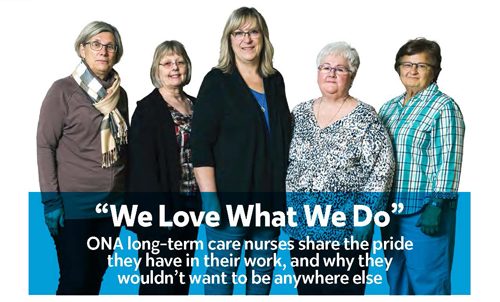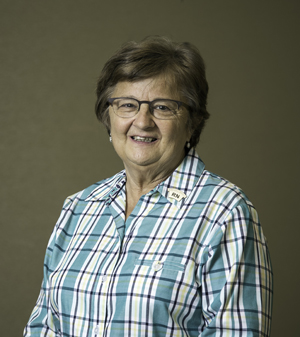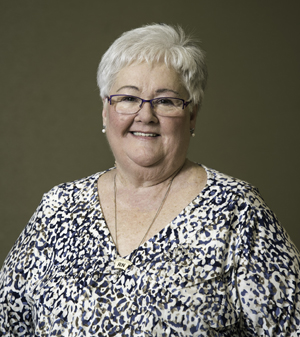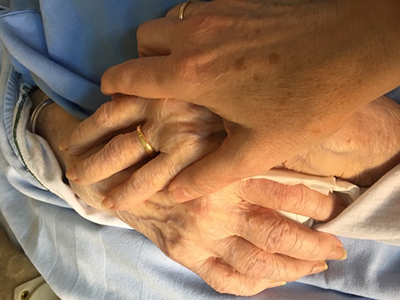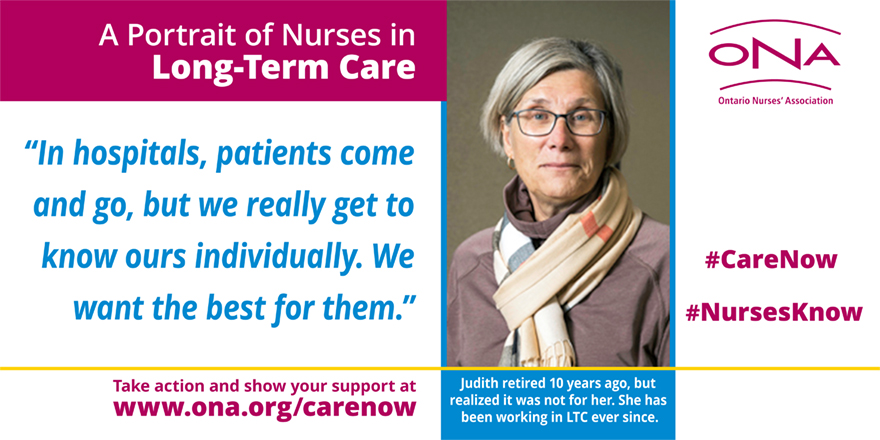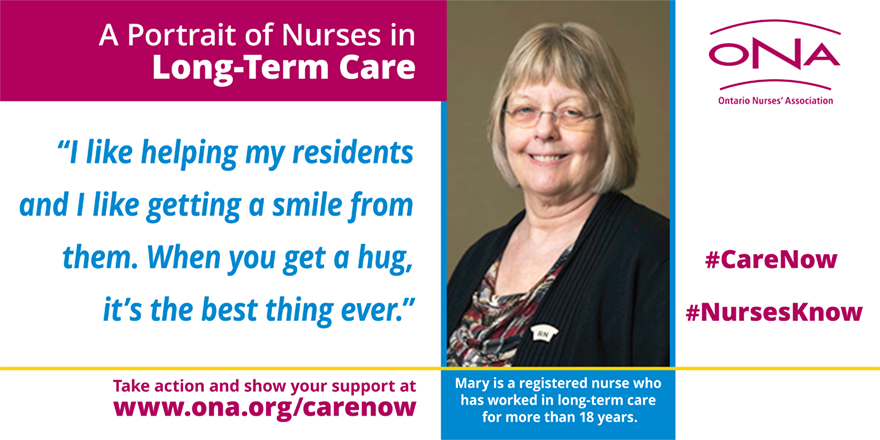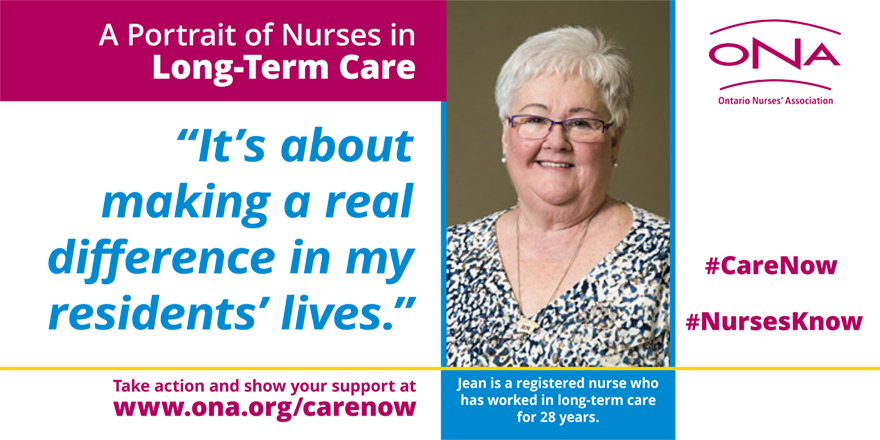ONA commissioned York University researchers to produce a report profiling the experiences of our long-term care registered nurses.
Click here to download and read “RNs in Long-Term Care: A Portrait.”
Our Stories
When the five Bargaining Unit Presidents on ONA’s Nursing Homes Central Negotiating Team talk about why they continue to work in long-term care, a path none of them originally chose, a common theme quickly emerges: they love their residents and are proud of what they do.
 When long-term care registered nurse Shelley Vandenberg talks about the residents she cares for, she understandably needs a moment.
When long-term care registered nurse Shelley Vandenberg talks about the residents she cares for, she understandably needs a moment.
“My residents are like family to me,” she said. “I love the interaction with them. They can tell you so many stories because they are so much older. Some can tell you about the war and the struggles they had as children. We get to know them on a personal level because they stay longer. In fact, we’ve had some residents in our home for more than 20 years.”
While Vandenberg, an RN for 23 years, didn’t begin her career in long-term care – she worked in a hospital (during nursing school), private nursing and the community before moving to the sector almost 14 years ago – she can’t imagine working anywhere else.
“I moved to long-term care for more utilization of my nursing skills, but I have never looked back. I absolutely love it.”
And it is that utilization of nursing skills that she said surprises many of her colleagues in other sectors.
“They don’t realize that our residents have multiple health conditions. It’s nothing for our residents to have eight to 10 diagnoses each. Nurses who have worked in the hospital sector are the first to say they had no idea how tough it is in long-term care because if you’re on a medical floor, you’ve probably got a four to six patient load max and in long-term care, we have all the residents.”
Sixty-one residents to be exact in Vandenberg’s case.
“During my shift, I do all the wound care, I don’t do meds until the supper pass, but then I complete all the assessments that allow the Resident Assessment Index (RAI), which is our funding basis, to be completed. I have to conference, report and update the care plan. We also have the support staff we supervise. On the weekends, we are responsible for all of the other departments, and 99 per cent of the time we are the maintenance person too. We are run-off our feet more so than anyone else. But we’re committed and that’s why we do it. We love our residents.”
But it is that love that also brings Vandenberg the greatest sorrow.
“We lost quite a few residents last year,” she said. “To us, they were each a person, they were our family and they were loved. You become attached to them and it’s very, very difficult when they do pass. It’s about personalities; we have quite the characters. I realize it’s very hard on the family, but it’s not any easier for us. I cry too, and the families say, ‘that shows that you loved our family member.’ Our home holds a memorial service every quarter and invites the families. A sheet is left at the desk so staff can write about each resident who has passed away, and they’ll talk about those comments at the memorial service. The families really like this because it shows them they weren’t just a person, they were actually cared about.”
Vandenberg also comforts herself in the fact that she is able to make her residents’ final hours the best they can be.
“Residents are sent to the hospital based on their advanced care directive. So Level 1 is you keep them at the home and comfortable. Do Not Resuscitate does not mean do not treat; if they have pneumonia and would have quality of life if they recovered, then we send them to the hospital or have a nurse practitioner come in and treat them. If they had a cardiac event that they are not going to recover from and they’re not going to have any quality of life, most family members tell us to keep them comfortable at the home with the people that know and love them the best. It’s a wonderful way for them to end their lives, with their nurses around them.”
The facility where Vandenberg works will be undergoing an expansion, and while she welcomes the news, she is equally concerned about the ability to staff it.
“There is a need to make it more appealing for a nurse to work in long-term care,” said Vandenberg, who is an ONA Bargaining Unit President, co-chair of the union’s Nursing Homes Central Negotiating Team and organized her home almost a dozen years ago because she wanted to make a difference to her members. “If we had more nurses in the sector, we could have support, so we’re not the only ones there.”
Still, she remains optimistic that the recommendations from the long-term care inquiry, which is examining the policies, procedures and oversight of the province’s long-term care homes, will address these issues in its final report, due this summer.
“I hope what comes out of the inquiry is more hours, more nursing care and more funding,” she concluded, noting “that when you get a thank you from a resident or their family, it makes up for so much. For residents and families to acknowledge and appreciate what we are doing for them truly makes a difference to me. Sometimes just a hug does it all. It means the world.”
When Sandy Kravets is asked why so few nurses choose to work in the long-term care sector, she is quick to respond: because they have never tried it.
“Unfortunately, for many nurses, long-term care is just not as enticing as other sectors and when you’re a stand-in, you don’t go to a nursing home to get the feel of it,” she said. “But they don’t know what they’re missing!”
After spending 38 of her 48-year nursing career in long-term care, Kravets knows of what she speaks.
“I was 19 when I graduated from nursing school and worked at a chronic care hospital at first. When I went on maternity leave, back then you only had a very short time, so I had to quit. A couple years later, I was missing my career, saw an ad in the paper, got the job and went to work at a nursing home in town. I’ve been there ever since! I started part-time and moved up to full-time throughout the years and it just worked out well for me. The first day I thought, ‘Oh boy, if I make it here a week that will be it.’ Yet, here I am all these years later!”
It is the camaraderie with her residents, along with their families, that Kravets said keeps her in the sector, along with the knowledge that even the simplest thing can make a huge difference to their quality of life.
“Some of our residents are in the home for a long time, so we watch their grandchildren grow up. The family brings these babies in their arms, then they are walking, then they are going to public school and high school, and before you know it, they’ve left home,” said Kravets, who helped organize her home in 1982 and has been a Bargaining Unit President for more than three decades. “Sometimes in the morning, our residents are up quite a bit before breakfast. You instinctively know they are looking for a cup of coffee and you just go and grab it for them, and it makes a whole world of difference. Just a cup of coffee. You know what they take in their coffee without having to ask.”
Kravets, who sits on ONA’s Nursing Homes Central Negotiating Team, also knows how they prefer to take their pills, which in itself can create some challenges.
“Maybe you have three hours for a medication pass in the morning, and the residents are going to be eating, but you can’t do this in the dining room and you can’t do that, according to Ministry regulations, which is a huge challenge. We’ve also got a window of time to give them their meds, which is a College of Nurses of Ontario standard, so an 8 a.m. medication means you’ve got an hour before and after to give it to them. You have all these residents to give meds to, but they don’t always just take them. They can’t swallow or they are spitting them out, and you know some like them crushed or have to take their 20 pills one at a time. So you could spend a long time with just one person. I have 60 patients on my shift. If I am not giving meds, the RPN is, but I’m in charge of everything else. We don’t have x-rays or MRIs or CAT scans to be able to able to find out what’s wrong with our residents. We have a stethoscope and a thermometer.”
It is for that reason that Kravets said much more needs to be done to attract nurses to the sector, who will stay for the long haul.
“With the Nursing Graduate Guarantee, new nurses had six months for orientation, which did the trick because then they were ready to go on their own and had a good handle on everything,” she said. “But when a nursing home hires a new RN now and they’ve got five days of orientation for two 12-hour shifts or three eight-hour shifts, they’re lost. They tell us, ‘I can’t believe what you guys do.’ It’s very hard to keep new nurses because of that. They go somewhere else and get paid more with better benefits. They haven’t had the opportunity to stick around long enough to fully appreciate the benefits of working in this sector.”
More personal support workers (PSWs) are also needed in long-term care so that residents are not waiting to go to bed or to the bathroom because there may be only two PSWs who are busy with five other residents.
“I try to let the PSWs know when they do something that’s just great,” concluded Kravets. “Just that little bit of encouragement, or a thank you, or noticing what they did can make their day. When the residents and families do that with me, it makes a huge difference.”
ONA Bargaining Unit President Judith Wright likes to joke that she is a 70-year-old nurse working in long-term care.
“I may not be the typical 70-year-old, but I’m still the 70-year-old nurse working in this sector,” she said. “I have been nursing for 48 years and spent most of that time in the hospital and community sectors. I retired 10 years ago at 60 years old, but quickly realized that retirement was not for me, and so I decided to try long-term care. I always felt like it was almost the forgotten sector.”
It was a decision she has not regretted.
“I currently work casual, but get enough shifts to keep me in the game – and it’s been very fulfilling, especially when I can make the residents smile,” said Wright. “Working in long-term care allows me to use my skills and be an advocate for my residents. A lot of them don’t have families and so nurses almost take on that role because there is a bond with our residents. In hospitals, patients come and go, but we really get to know ours individually. We want the best for them.”
As the sole RN on a shift, working closely with registered practical nurses (RPNs) and personal support workers (PSWs), Wright is responsible for the overall care of the residents in her home, which has 122 beds and nine convalescent beds, for a total of 131.
“Staffing is the number one issue in the long-term care sector,” she said. “To do a proper assessment can take at least 20 to 30 minutes, and then charting. Nurses deal with residents that become agitated, some of whom suffer from dementia, and documentation needs to be done. We assist when there is a shortage of RPNs or PSWs, who work so hard. When there is a crisis within a facility, often nurses are called immediately. We also help with resident care and medications. Privatization has also made long-term care very challenging. Patient care must always be the priority in long-term care, and more public funding should be put towards supporting staffing and care in the sector.”
When Wright, who has no immediate plans to retire again, envisions the kind of long-term care system she would like to see in this province, she doesn’t have to look very far.
“We need to consider changing the model in long-term care in general because we’re all getting older, and what is our expectation if we have to go into a nursing home? How do we want to be treated? I would like to have a face cloth and a warm basin of water given to me. I want my hands washed before I go to breakfast. I think we’d all want that.”
And, she is hopeful that the long-term care inquiry, which is examining the policies, procedures and oversight of the province’s long-term care homes, will issue recommendations to help make that a reality when it releases its final report this summer.
“I have followed the inquiry very closely and I am optimistic it will address the issues around hours of work and staffing in the long-term care sector. I am really hoping the inquiry will do the right thing for the sake of the residents of this province.”
Until then, Wright, who has been a member of ONA’s Nursing Homes Central Negotiating Team for three rounds, comforts herself in the knowledge that nurses like her choose to work and stay in long-term care “because this is where we want to be, as we feel we do make a difference to our residents.
“Nurses are very dedicated people,” she concluded. “We want what’s best for whomever we are taking care of. That’s the bottom line. It’s also the camaraderie and the personal connection that we have with families and residents. For example, we had a resident recently pass away and I had to call the family beforehand to say he had taken a turn for the worse. Two of the children were out of the country and asked me to please be frank with them. I said, ‘you need to come’ and so they flew back. We don’t have a palliative care room, so the entire family spent five full days with this resident in a lounge area so they could have privacy. They brought inflatable mattresses. And their comment was, ‘we can’t thank you enough.’ They said the staff here is the best. So, that says a lot about how much we care for our residents. It made us feel so good.”
Mary Clarke, who works at a Toronto long-term care home, wants to clear up a common misconception: Long-term care nurses have the same skills as their hospital counterparts, they just use them differently.
“The reason many nurses don’t pick long-term care is because they just don’t know,” she said. “There’s a stigma associated with working in nursing homes; yet, we have the same skills, we just use them in different ways. And, we don’t have doctors around all the time like a hospital. When our residents present with worsening conditions, we’re there doing our oscillations and assessments to determine whether it’s safe to treat them in the home or if we should send them to a hospital. We also communicate with the family throughout. Long-term care nurses often go home tired, frustrated and wishing they could have done more.”
And Clarke should know, having begun her career 40 years ago at a Toronto hospital. While she really enjoyed volunteering at a camp for the elderly as a teenager, it wasn’t until she lost her full-time hospital hours and bumped into part-time due to government cuts that she made her first foray into long-term care. Needing to make up the difference in hours, she found casual part-time work in a nursing home, which over the years, turned into a full-time job. While Clarke has worked at three different nursing homes throughout her career, she has remained at her current home for the past 18 years, which is particularly meaningful to her as she helped open the facility.
“I thought that would be an interesting experience – and it was! We were very busy, and doing all the paper work on every single resident, and I got to know each and every person in the building. We have 160 residents, so it was lot of work, but it was fun as well. Everyone was hired at the same time and we were all doing the same thing.”
And now she can’t imagine working anywhere else.
“I realized when I moved to long-term care that this is where I want to be,” said Clarke, who has been a Bargaining Unit President since 2005 and sits on ONA’s Nursing Homes Central Negotiating Team. “I like helping my residents, I like getting a smile from them, and a pat on my hand when one of them says, ‘thank you, dear, you made a difference.’ When you get a hug, it’s the best thing ever.”
While her nursing home has social programs to engage and entertain residents, including card and bingo games, sing-alongs and classic movie nights, Clarke said she also enjoys going the extra mile for them.
“I have oceans of books at home and so if I see that one or more of my residents like to read, I’ll bring some of those books in and we rotate them around, so they get a chance to do something different. You do develop relationships with your residents. They almost become your own grandparents and when they pass away, it’s devastating.”
But long-term care, like any sector, is not without its challenges.
“You’re giving meds, but you’ve got someone who may have fallen and you’ve got someone else who has turned sour and you need to send them to hospital, and there’s a lot of paper work involved in that. Or you have someone coming back from the hospital, and you have the doctor coming in, and you have rounds and orders. We have nurses come in and they go through the orientation and say, ‘How do you do it?’”
But Clarke is hopeful that the LTC inquiry, which is examining the policies, procedures and oversight of the province’s long-term care homes and will issue recommendations this summer, will address workload issues in the sector.
“We need more RNs in long-term care, bottom line,” she concluded. “The registered practical nurses (RPNs) and the personal support workers are working really hard and we need to say thank you to them more often because they don’t hear it. And, RPNs, more and more, are taking care of patients that are unstable, and that should not be happening. But when I get a smile from a resident who typically doesn’t show that much expression or a family member saying ‘thank you,’ it’s all worth it to me.”
For long-term care registered nurse Jean Kuehl, the grass is not greener on the other side of the fence.
“I would never go to another sector to work,” said Kuehl, who has worked for 28 years at a long-term care home in Kitchener and has been a Bargaining Unit President for 18 of those years. “The challenges are different in different settings, of course, but by this time, we know what we’re facing in long-term care and can deal with them. And, we’ve mastered a lot. I began my career working part-time in community nursing because there weren’t many opportunities at that time. But once I moved into long-term care where there were jobs, I never looked back. I love it.”
Then again, that’s something Kuehl already knew, having worked in long-term care homes throughout her high school years in the laundry and dietary departments, and as a guest attendant.
“My mother worked in long-term care and it seemed like a good place to get a part-time job as a teenager,” she said. “So I was always surrounded by and connected to the sector, and I had a very clear picture of what it entailed. My mother even brought people home for meals, and at Christmas, we always had residents at our house for special dinners.”
Now, three decades later, it is that connection with the residents, who tend to stay for long periods of time, along with their family members and staff, that Kuehl said she loves the most.
“It’s about making a real difference in my residents’ lives,” she said. “If they are hurting, I can help ease that suffering for the most part. I can make them warm. I can get them something to eat. I can help them find something that’s lost. I can help them with social activities. Those little things are all about quality of life.”
While she added that it’s “very, very difficult” when a resident passes away, “I think that’s when our nursing skills really kick in because we try to comfort the family. If we, as staff, are connected to those residents, then they are more than connected to their own families most of the time.”
Yet, it is those very skills that Kuehl feels are misunderstood in long-term care.
“People think we just sit at a desk and supervise because these patients aren’t acute,” said Kuehl, a full-time wound care nurse who will also give medication to 30 residents on the day shift when they are short-staffed. “Nothing could be further from the truth! We’re charged with meeting all the residents’ needs – physical, spiritual, social and otherwise – and we also have to document what we’ve done and how we’ve done it, and did it work, and if it didn’t work, what are you going to do about it? So, there is a lot of thought and work that goes into ensuring our residents have that quality of life.”
And all that work must be done while meeting both the Ministry of Health and Long-Term Care regulations for long-term care homes and the College of Nurses of Ontario (CNO) standards.
“The regulations are incredible,” said Kuehl, who is also co-chair of ONA’s Nursing Homes Central Negotiating Team. “If you are a nurse who is giving out medications, you’ve got your CNO standards to meet and all the rights people have when they are given medications, plus the Ministry tells you where you are going to give those medications. You’re not taking your nursing cart into the dining room, and you’re supposed to give them within a certain time frame. You’ve got to meet all of that while maintaining privacy for that resident. Because you are the RN, you are also making sure all the residents are in the dining room for meal times so their nutritional needs are met. If a resident is not there, you’d better know why.”
Kuehl also feels that the long-term care inquiry, which is examining the policies, procedures and oversight of the province’s long-term care homes, has made an impact.
“I think the inquiry made me think long and hard, more so than I ever did, about what did I do today, did I do it according to the regulations, where is it on the priority scale, what am I going to do about it? It’s made us fearful and anxious.”
At the same time, she is hopeful the LTC inquiry recommendations, which will be issued this summer, will result in meaningful changes for what ails the system. She also has a few solutions of her own.
“The working conditions in long-term care need to be addressed through more funding. Over the years, we have seen the Sharkey Report [which, in 2008, called for guidelines over the following four years to provide Ontario’s long-term care residents with up to four hours of care each day] and others, and all of them have said long-term care needs more staff and more funding, whatever that looks like, but it just hasn’t happened. It needs to happen now.”
Until it does, Kuehl said she chooses to focus on the positive.
“During the holidays or when their loved one passes away and the family gives you a card saying, ‘thank you so much for what you do,’ it makes all the difference. The fact that you don’t get off work on time and there aren’t enough hours in the day fades away completely – because that’s what really matters.”
This opinion piece was provided to the Ontario Nurses’ Association by author Karen Cumming. It was originally published in the Hamilton Spectator on May 10, 2019, and is reprinted here with permission.
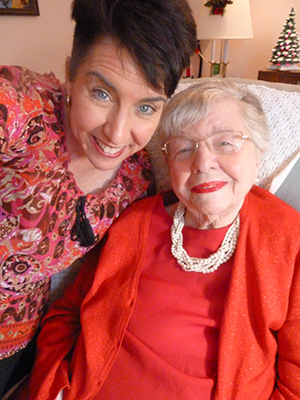
One of many Christmases together. This one, at Verna’s assisted living facility in Grimsby (Karen Cumming photo).
It’s something that all of us will go through — yet few of us are truly prepared.
A few months ago, my sister and I held our mother’s hand as she drew her final breath. Even now, it continues to feel surreal. The woman who gave life to my sister, brother and me, is gone.
Her name was Verna Amelia and she was in her in her 99th year. Our mom grew up on a farm in Tapleytown in the 1920s, survived tuberculosis, studied to be a bookkeeper, then worked for the local hydro office and the Royal Bank. She married our dad during the Second World War and went on to become the classic stay-at-home mother.
After dad passed away in 1999, mom lived another 15 years alone in her home. She was diagnosed with breast cancer and underwent a mastectomy and radiation at the age of 86. Later, she moved to an assisted living facility in Grimsby run by Niagara Region, and spent the last three-and-a-half months of her life in long-term care in Niagara-on-the-Lake. It was there that her congestive heart failure, edema and kidney failure got worse. Her body just gave out in the end.
Our mother’s journey through the Ontario health-care system was a long and winding road that was exhausting at every turn. Perhaps you have already experienced the loss of your mother or father. Perhaps that journey is yet to come. It’s something that all of us will go through – yet few of us are truly prepared.
Finding a Facility Your Parent Can Afford
The day will likely come when your parent can no longer manage living at home. If they are unable to afford care in a private facility, they will have to face the reality of publicly funded assisted living and/or long-term care.
Assisted living will provide a modest room with limited space for furnishings, a three-piece bathroom, laundry service, recreational activities, exercise classes, assistance with dressing, and three meals a day in a dining room that your parent must be able to walk to or access with a walker or a wheelchair.
Long-term care will provide a similar room and amenities, plus a nurse on duty 24-7, control and administration of all medication, and assistance from personal support workers for toileting, getting out of bed, dressing, and getting into bed after meals and at night. Our mother paid $2,418.74 per month for her private room – a few hundred dollars less than the standard provincial rate because her long-term care facility was slightly older than some of the rest.
At some point, you and your parent may have to navigate the transition from assisted living to long-term care. How will you know it’s time? When your parent is bedridden and/or unable to walk, they are no longer eligible to stay in assisted living. You will then have to get them on what is known as the “crisis list” for long-term care.
There are 86 long-term care facilities in the Hamilton Niagara Haldimand Brant Local Health Integration Network or LHIN. Bear in mind your parent has likely never seen any of these places. Chances are, neither have you. And the LHIN case worker in charge of getting you on the waiting list won’t have any photos or videos on hand in order to show you what the facilities look like.
Even in the midst of a crisis situation, the LHIN will suggest that the onus is on you to arrange tours of these long-term care homes before you compile your list of preferred choices. If you choose not to do this, you’re pretty much relying on word of mouth to make one of the most important decisions you’ll ever face.
Welcome to what could be one of the most frustrating experiences of your life. In no particular order, you may feel helpless, overwhelmed, exhausted, incredulous and exasperated.
You will soon discover the key players in the system don’t seem to talk to each other much. You may spend a great deal of time advocating on your parent’s behalf, tracking down LHIN case managers and doctors and nurses to confirm the latest developments each day. We kept a spiral bound notebook in our mom’s room at all times. Inside it, we recorded the date and details of every conversation we had with just about everyone involved. It was a lifesaver.
A Crisis Situation
As soon as tomorrow, your parent could suddenly be in a crisis situation. Decisions will need to be made quickly. The crisis may come at you out of nowhere and hit you like a ton of bricks. In a perfect world, it might sound reasonable to line up a tour of five or 10 long-term care facilities right away. In reality, life has a tendency to get in the way. One of the most important decisions you will ever make for your parent could all come down to a handful of photos you find in desperation one night on the internet.
You will have to indicate whether you’d like a ward room with four beds, a semi-private room with two, or a private room with one. Each option comes with its own price point. Because our mother could no longer walk, we needed to find a place for her quickly. We held out for a private room because that was important to her, but we also put 10 long-term care homes on our crisis list to increase our chances of getting a bed fast.
It’s a callous kind of process, really. Once you submit your list of choices, you then wait for someone to pass away so your parent can be offered a bed. This could take weeks. In our mom’s case, it took about a month. Once you receive an offer, you have 24 hours to accept and move within five days. If for any reason you choose not to accept the offer, your parent’s name must come off the crisis list entirely for three months; then they must apply all over again. Those are the rules.
Angels along the Way
But here’s the good news. You will meet angels along the way. The personal support workers (PSWs) who were assigned to our mom in long-term care were the most kind-hearted, compassionate souls imaginable. They greeted her with a cheery, “Good morning, Verna!” at 6 a.m., washed her, toileted her, helped her to put her teeth in, dressed her and wheeled her to the dining room and back again after each meal. They repositioned her in her bed when she became uncomfortable, and brought her snacks and fresh water throughout the day. They were love personified. The nurses were, too – ready to administer additional medication whenever the pain became unbearable.
The degree to which these angels are overworked shocked us. CBC’s “Marketplace” recently went undercover with a hidden camera to a Toronto area long-term care home. Much of what the CBC encountered there, I saw with my own eyes in my mom’s facility. The call bells that residents press for help would often ring for extended periods of time because there weren’t enough people available to answer them all in a timely way.
When staff called in sick, they couldn’t always be replaced on short notice.
On my mother’s ward, just two PSWs worked the early morning shift. They had the task of waking up more than a dozen residents, getting them washed and dressed, wheeling them out to the dining room, preparing and then serving the food. They also had to feed those residents who were no longer able to feed themselves. After the meal, they would wheel the residents back to their rooms and get ready to start all over again in preparation for lunch. It was a marathon, not a sprint.
The RN on duty each shift was so swamped with work that I got into the habit of prefacing my request for more medication for my mother with the words, “I know you’re busy, but when you have a chance, could you please help us?”
One thing I know for sure: the PSWs and nurses have the very best of intentions. There just aren’t enough of them.
Each evening around 7:30, I would brace myself as I called our mom to ask how she was feeling. It was common for her to tell me that she was still in her wheelchair an hour after dinner had finished, and was still waiting for a PSW to take her to the washroom. Heartbreaking. I’d do my best to calmly reassure her that someone would be there soon. Then I would hang up and call the nurse’s station to ask for help. Sometimes, the phone would go unanswered. The nurse was too busy elsewhere … nursing. It was just about as frustrating as it gets.
Thankfully, there is Bill 13 — proposed legislation that would require long-term care homes in Ontario to provide “a minimum care standard of an average of four hours of hands-on care to residents each day.” There are petitions circulating inside some long-term care homes now in support of it.
Clearly, there is a human tsunami heading our way. It’s a tidal wave of mothers and fathers like yours and mine who will soon need a higher level of care than they currently enjoy in their own homes or assisted living facilities. Unfortunately, it would seem the current system is not up to the task.
Video
Ellen’s Story
Simerjit’s Story
Jean’s Story
Radio
Shareables
We have created shareable images that you can download and post to your social media accounts. Help share our stories.

